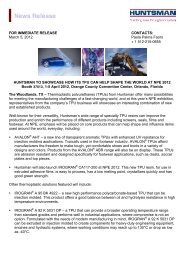Polyurethane Insulation: Reducing Building Energy ... - Huntsman
Polyurethane Insulation: Reducing Building Energy ... - Huntsman
Polyurethane Insulation: Reducing Building Energy ... - Huntsman
You also want an ePaper? Increase the reach of your titles
YUMPU automatically turns print PDFs into web optimized ePapers that Google loves.
<strong>Polyurethane</strong> <strong>Insulation</strong>:<br />
<strong>Reducing</strong> <strong>Building</strong> <strong>Energy</strong> Consumption<br />
• ~40% of the overall U.S. energy demand goes<br />
into the building sector<br />
Computers<br />
Other<br />
Wash<br />
Residential <strong>Building</strong> <strong>Energy</strong> Consumption<br />
Electronics<br />
Cooking<br />
Refrigerators<br />
Transportation<br />
28%<br />
Commercial<br />
<strong>Building</strong>s<br />
18%<br />
Residential<br />
<strong>Building</strong>s<br />
21%<br />
Industrial<br />
33%<br />
• ~40% of the energy<br />
used in buildings<br />
goes into heating<br />
and cooling<br />
Cooling<br />
Lights<br />
Water Heating<br />
<strong>Building</strong> Heating<br />
Computers<br />
0 5 10 15 20 25 30 35<br />
% of Total Consumption<br />
Commercial <strong>Building</strong> <strong>Energy</strong> Consumption<br />
Cooking<br />
Refrigerators<br />
• PU insulation in the building envelope can<br />
reduce heating and cooling energy loads<br />
significantly<br />
Source: EIA<br />
Ventilation<br />
Office Equipment<br />
Water Heating<br />
Other<br />
Cooling<br />
<strong>Building</strong> Heating<br />
Lights<br />
0 5 10 15 20 25 30<br />
% of Total Consumption<br />
PU insulation products have some<br />
of the highest R-values<br />
PU insulation products help reduce energy<br />
loss through air infiltration<br />
The higher the R-value, the better the material<br />
serves as insulation from heat transfer.<br />
R-value is a measure of the thermal resistance<br />
of a material.<br />
Air infiltration<br />
Un-insulated stairwell<br />
Brick 0.2<br />
Concrete<br />
0.3<br />
Plywood<br />
1.3<br />
Fiberglass/RW<br />
3.5<br />
Cellulose<br />
3.5<br />
Polystyrene<br />
4.7<br />
<strong>Polyurethane</strong><br />
6<br />
0 1 2 3 4 5 6<br />
R-Value/Inch<br />
Thermal bridging from metal studs<br />
and structural members<br />
According to the U.S. Dept. of <strong>Energy</strong> (DOE),<br />
the average home spends $1,300 annually on<br />
heating/cooling utility costs. Studies show that<br />
40% of that energy is lost due to air infiltration.<br />
Source: 2007 <strong>Building</strong> <strong>Energy</strong> Databook, Table 4.21, 2005 <strong>Energy</strong> Cost Data<br />
PU insulation helps meet energy reduction targets<br />
• Federal <strong>Building</strong>s: Executive Order 13514 – All new federal buildings net zero<br />
building energy requirement by 2030<br />
• Architects: AIA 2030 target: net zero energy buildings by 2030<br />
• <strong>Building</strong> Codes: Ashrae 90.1, IECC 2009 higher R-value requirements
<strong>Huntsman</strong><br />
10003 Woodloch Forest Drive<br />
The Woodlands, Texas 77380<br />
Email: sprayfoam@huntsman.com<br />
www.huntsman.com/sprayfoam<br />
Tel: (281) 719-4914











